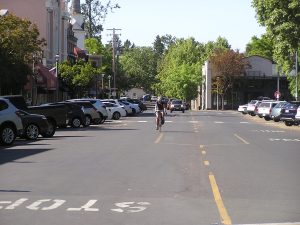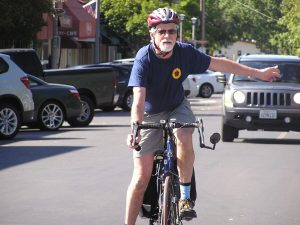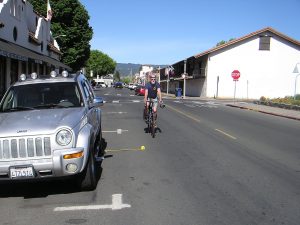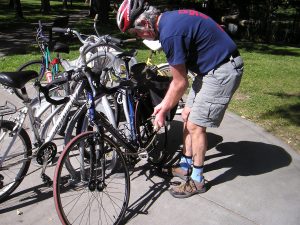Top 10 Things to Know About Bikes
Written by Sarah Hadler, Program Manager and League of American Bicyclist Cycling Instructor #3909 with the Sonoma County Bicycle Coalition
 1—The safest and best place for a bicyclist to be is on the right side of the road travelling in the same direction as traffic. Bicyclists should ride as far right as is practicable and safe for them to do so. Motorists cannot often see what a bicyclist sees on the roadway. A bicyclist may be riding further out to the left than expected because there may be debris or a pothole in the road or she may be preparing to make a left turn.
1—The safest and best place for a bicyclist to be is on the right side of the road travelling in the same direction as traffic. Bicyclists should ride as far right as is practicable and safe for them to do so. Motorists cannot often see what a bicyclist sees on the roadway. A bicyclist may be riding further out to the left than expected because there may be debris or a pothole in the road or she may be preparing to make a left turn.
Note: Bicyclists are allowed to ride on the sidewalk in Sonoma (except on the sidewalks in the downtown Plaza area, SMC 10.74.010) but they must yield to everyone else using the sidewalk. It is not recommended that bicyclists ride on the sidewalk, because motorists generally do not expect bicyclists to be there. Bicyclists should ride in the roadway where they are more visible and predictable.
 2—Bicyclists should obey all traffic signs and signals. Bicyclists and motorists share the same roads and follow the same rules and have the same responsibilities. Road users who follow normal traffic patterns are safer and less likely to get in a crash than road users who make up their own rules.
2—Bicyclists should obey all traffic signs and signals. Bicyclists and motorists share the same roads and follow the same rules and have the same responsibilities. Road users who follow normal traffic patterns are safer and less likely to get in a crash than road users who make up their own rules.
3—Bicyclists can take the full lane in order to be safe and they have the legal right and responsibility to do so. If a lane is too narrow to share, the bicyclist can communicate that by riding in the center of the lane; this discourages unsafe passing by a motorist. The bicyclist will then move over to the right when it is safe to do so. When bicyclists ride two abreast in the roadway, it is not intended to make motorists angry, rather it makes them more visible and discourages close passing in the lane.
Note: Bicyclists may also leave the bike lane if it is not the safest place to be. Some reasons why bicyclists leave the bike lane are to avoid hazards, to stay away from parked cars and the door zone, to make a left turn or to make a right turn from a right turn only lane.
4—All road users should be extra alert around intersections. About a third of the crashes that involve bicyclists and motorists happen at intersections. Bicyclists move faster than one might think—motorists should consider this when passing or pulling into an intersection in front of a bicyclist. Motorists should allow as much space as they would another motorist.
5—Driveways can be problematic to bicyclists, especially youth on bicycles. If a bicyclist is exiting a driveway, he should treat the end of the driveway as a stop sign and always check and make sure it is clear before heading out onto the roadway. Motorists should always be extra cautious and check their blind spots when backing out of a driveway.
 6—Be aware of the door zone. Bicyclists should give themselves 3-4 feet when passing a parked car so that they do not get hit by a door opening. Motorists should always look before opening their door, it is suggested that motorists use their right hand to open the door because this makes them look behind to see if anyone might be coming.
6—Be aware of the door zone. Bicyclists should give themselves 3-4 feet when passing a parked car so that they do not get hit by a door opening. Motorists should always look before opening their door, it is suggested that motorists use their right hand to open the door because this makes them look behind to see if anyone might be coming.
7— It is the law in California that everyone under the age of 18 must wear a properly fitted and fastened helmet. And it is highly recommended that bicyclists of all ages wear a helmet. Think of a helmet like the seatbelt in your car and always put on a helmet before hopping on your bike.
8—Motorists are required to give a bicyclist three feet when passing. This law was passed in California in 2014. A motorist can only pass a bicyclist when it is safe to do so. The center line should not be crossed unless there is a sufficient view to see that there are no on-coming cars; hills are never a safe place to pass.
9—Remember PVC! P is for being predictable, V is for being visible and C is for Communicating. When bicyclists (and motorists, too!) do these three things, they are going a long way to keep themselves, and those around them, safe. Bicyclists should follow all traffic rules, wear bright colors and have lights on their bikes, and signal intentions to turn and stop.
 10—Bicyclists fare best when they act and are treated as drivers of vehicles. Bicyclists are people, just like motorists, with families who want them to arrive home safe and sound. And most bicyclists are motorists at times as well. All road users should try to keep themselves and everyone around them safe and know that a few seconds of lost time are nothing compared to potentially causing a life-threatening crash. Be thankful when you see a bicyclist, it’s one less car on the road.
10—Bicyclists fare best when they act and are treated as drivers of vehicles. Bicyclists are people, just like motorists, with families who want them to arrive home safe and sound. And most bicyclists are motorists at times as well. All road users should try to keep themselves and everyone around them safe and know that a few seconds of lost time are nothing compared to potentially causing a life-threatening crash. Be thankful when you see a bicyclist, it’s one less car on the road.
